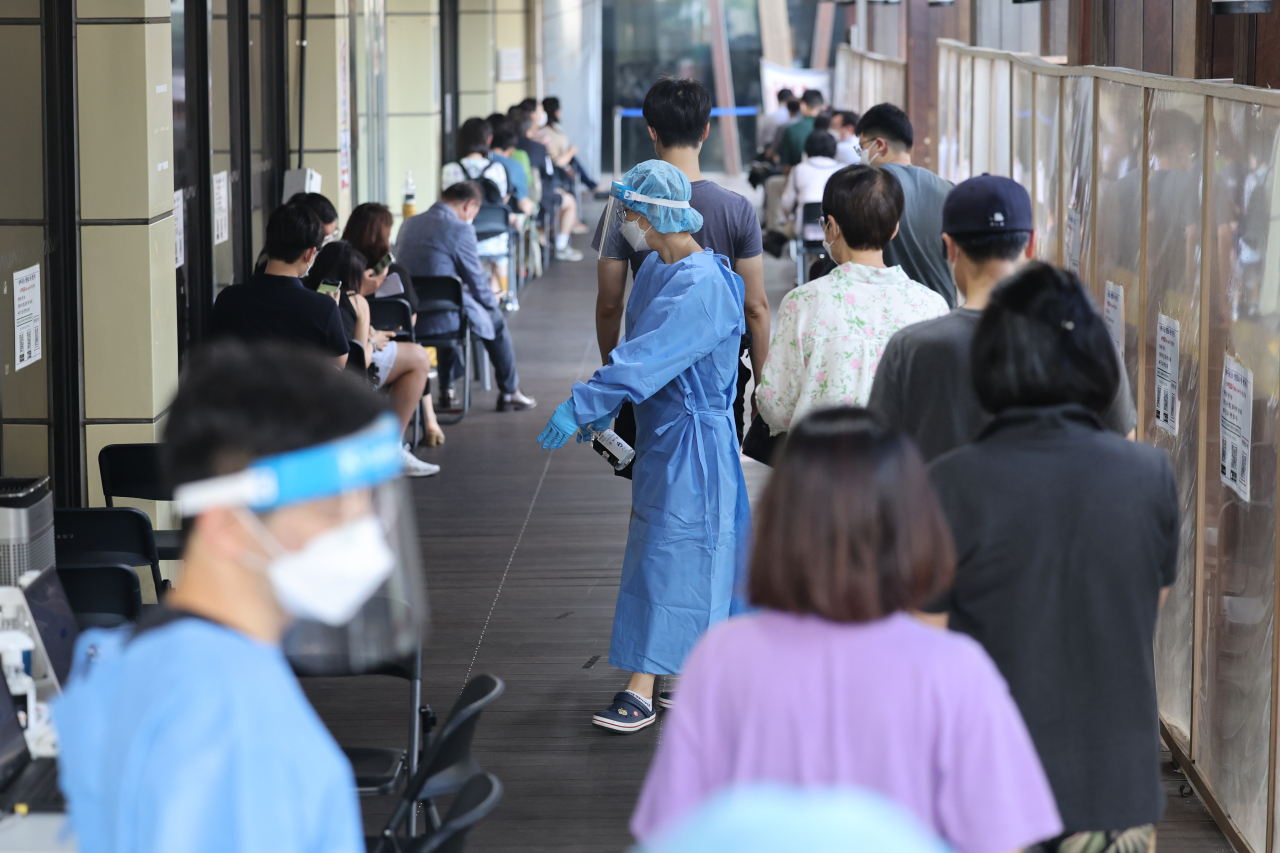
People line up to take a COVID-19 test at a testing clinic in Songpa, southern Seoul, on Friday. (Yonhap)
COVID-19 reinfections appear to be rising, and the average time until reinfection is getting shorter.
According to the Korea Disease Control and Prevention, the number of suspected cases of reinfection in the third week of July recorded 28,966, accounting for 6.5 percent of the cases newly confirmed that week. In the second week of the same month, the share of suspected reinfections was 3.7 percent or 8,895 cases.
Suspected reinfection means a positive test more than 90 days since the last infection, regardless of symptoms, or a positive test accompanied by symptoms or following exposure more than 45 days since the last infection.
Lim Sook-young, a senior KDCA official, told reporters Tuesday that reinfections becoming more frequent was attributable to multiple factors such as BA.5 replacing earlier omicron subvariants as the dominant COVID-19 virus, waning immunity from prior infection or vaccination.
“Our analysis indicates that the more doses you receive, the less likely you are to be reinfected,” she said. “Without vaccination, prior infection alone cannot cut your risk of reinfection.”
She said that compared to people who aren’t vaccinated, the risk of reinfection was down by 48 percent for people who completed their primary vaccine series and by 74 percent for people who were boosted with a third dose.
Last month South Korea expanded the eligibility for fourth doses to people in their 50s as well as people of all ages with certain clinical vulnerabilities. As of Thursday midnight, 40 percent of people aged 60 years and older have received their fourth doses.
The time from one infection until the next infection has also become shorter. In June, the average time between the first infection and reinfection was 229 days. In July it was 154-165 days, according to the KDCA.
The KDCA said reinfections were most commonly reported among young people under 18 years of age and people who have never been vaccinated. People younger than 18 comprised 49.2 percent of suspected reinfection cases in July. Of all the cases found here since the beginning of the pandemic, 23.1 percent are in the under-18 age group. Unvaccinated people, who are just 12 percent of the entire population, made up nearly half of July’s suspected reinfection cases.
Reinfection with BA.2 following a first infection with BA.1 is suspected to be most common form of reinfection, based on the timing of the positive tests, the KDCA said.
Out of all 142,513 suspected reinfection cases to date, 36.5 percent tested positive for the second time when BA.2 was dominating after testing positive initially when the dominant variant was BA.1. This was followed by 23 percent whose positive tests were during delta and BA.2, respectively, and 11.2 percent who had theirs during delta and BA.1.
The KDCA warns that clinically vulnerable people face a higher risk of severe illness from reinfection.
Infection with earlier omicron subvariants of BA.1 or BA.2 combined with vaccination may offer some protection against reinfection with the more recent BA.4 or BA.5, according to Dr. Jerome Kim, the director general of the International Vaccine Institute based in Seoul.
“Infection with BA.1/2 appears to confer some, incomplete protection against BA.4/5 infection and mild disease. Hybrid immunity -- that is, vaccination plus infection -- confers protection against severe disease, hospitalization, and death,” Kim told The Korea Herald.
But being hybrid immune will not prevent another infection.
“Will prior vaccination plus BA.1 infection protect against the worst manifestations of BA.5? Yes,” he said. “Will it protect you against getting BA.5? No. Can a person infected with BA.5 be reinfected with BA.5? Yes.”
The International Vaccine Institute chief added that the data are “very dirty at this point because in many places not all infections are being diagnosed and many are not being reported.”
Dr. Kim Woo-joo, infectious disease professor of Korea University, agreed that while repeat infections with COVID-19 were becoming the “new norm,” lack of testing could be holding back surveillance.
Over the seven-day period from Aug. 2-8, only 183,327 PCR tests were carried out per day on average. Access to PCR testing is limited to people aged 60 and above.
Hospitalizations and deaths, considered “lagging indicators,” are once again on the rise about a month since BA.5’s share of new cases crossed 50 percent.
In the first week of August, 324 patients were severely or critically ailing, up by 35.6 percent from the week before. By Thursday afternoon, 40.8 percent of all critical care beds and 60.6 percent of semi-critical care beds were occupied across the country. Over the same week 209 patients died, marking a week-on-week increase of 21.5 percent.
By Kim Arin (
arin@heraldcorp.com)




![[From the Scene] Monks, Buddhists hail return of remains of Buddhas](http://res.heraldm.com/phpwas/restmb_idxmake.php?idx=645&simg=/content/image/2024/04/19/20240419050617_0.jpg&u=20240419175937)

